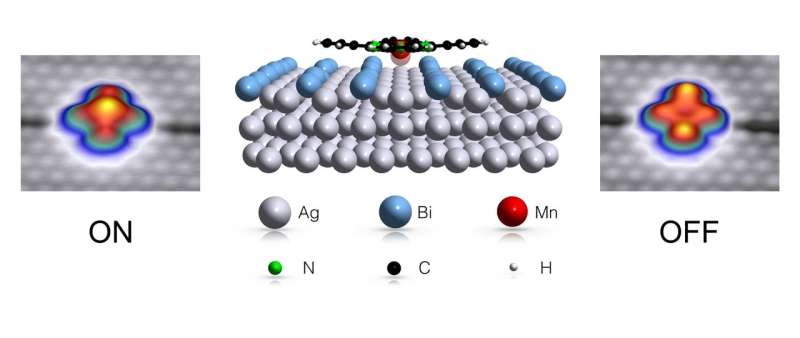Environment turns molecule into a switch

It looks like a cross with four arms of equal length that have a central atom at their intersection. All atoms are arranged in one plane so that the molecule is absolutely planar – at least in the normal state.
Physicists from the University of Würzburg have now succeeded in manipulating this molecule using a special deposit and an electrical field to permanently take on two different states. This could make the molecule suitable as a kind of "molecular switch" for spintronics applications – a trailblazing data processing technology based on electron spin.
The molecular switch is the fruit of a collaboration of members from the Departments of Experimental and Theoretical Physics at the University of Würzburg: Dr. Jens Kügel, a postdoc at the Department of Experimental Physics II, devised and ran the experiments. Giorgio Sangiovanni, a Professor of Theoretical Physics at the Institute of Theoretical Physics and Astrophysics, was in charge of interpreting them. The team has recently published their research results in the current issue of the journal npj Quantum Materials.
Building a bridge with a dye molecule
"We used a manganese phthalocyanine molecule, a dye which cannot be normally switched," Sangiovanni describes the physicists' approach. Jens Kügel had to resort to a trick to turn it into a molecular switch: He mounted the molecule on a very special metallic surface built of silver and bismuth atoms.
Because bismuth atoms are much bigger than silver atoms, their regular arrangement covers the metal surface like low walls. Irregularities in this structure result in a larger distance between two bismuth areas like a dried-up riverbed. The manganese phthalocyanine molecule then builds a bridge across this riverbed to continue the metaphor.
Switched by an electric field
Jens Kügel used a special technique to give the molecule its switching property. When he approached the manganese atom at the centre of the molecule with a very fine tip that emitted an electric field, the central atom changed its position and moved down a bit towards the metallic surface out of the molecular plane. "In this way, the molecule took on two stable switchable states," the physicist says.
Physically, the molecule creates a large magnetic moment due to the position change of its central atom. Because of special quantum physics phenomena, this change of position affects the entire molecule, manifesting externally through distinctly different magnetic properties. Physicists refer to this as the Kondo effect.
A new concept to build molecular switches
Normally, molecular switches are synthesised to be intrinsically stable in multiple states. "We have now demonstrated that this functionality can be created also in non-switchable molecules by selectively manipulating the molecule's environment," Kügel and Sangiovanni explain the central result of their paper. The physicists have thus developed a new concept to build molecular switches which they believe will open up new design possibilities in molecular electronics in the future.
Successful cooperation in the Collaborative Research Center
The successful collaboration of theoretical and experimental physicists at the University of Würzburg is also based on the Collaborative Research Center "Topological and Correlated Electronics at Surfaces and Interfaces", short ToCoTronics, which is located in Würzburg. Its focus is on special physical phenomena – electronic correlations and topological physics, and above all, their interactions which have huge application potential for novel, trailblazing technologies of tomorrow.
More information: Jens Kügel et al. Reversible magnetic switching of high-spin molecules on a giant Rashba surface, npj Quantum Materials (2018). DOI: 10.1038/s41535-018-0126-z
Provided by Julius-Maximilians-Universität Würzburg




















